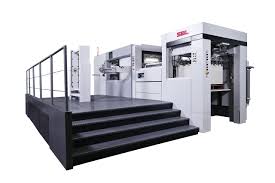
Die cutting technology has evolved significantly over the years, revolutionizing industries such as packaging, printing, textiles, automotive, and more. The latest advancements in die cutting technology have enabled manufacturers to improve both the efficiency and quality of their production processes, offering a wide range of benefits from faster turnaround times to precision cutting. In this article, we explore how the latest die cutter technology can help businesses maximize their efficiency and quality in manufacturing and production.
1. Understanding Die Cutting Technology
Die cutting is a manufacturing process that uses a die (a sharp metal blade) to cut materials into specific shapes, designs, or patterns. It is commonly used for cutting paper, cardboard, rubber, plastic, fabric, and other materials. The die is created in the desired shape, and the material is pressed into the die, which cuts it into the final shape.
Over the years, die cutting technology has evolved from manual methods to fully automated, computer-controlled processes that offer enhanced precision and speed. Modern die cutters are equipped with advanced features such as sensors, digital controls, and robotic arms, all contributing to higher levels of automation and customization.
2. Key Advancements in Die Cutter Technology
The latest die cutter technology offers a range of enhancements that significantly improve efficiency, precision, and overall quality in manufacturing processes. Here are some key advancements:
a. Laser Die Cutting
Laser die cutting uses a high-powered laser to cut materials, providing exceptional precision and flexibility. Unlike traditional die cutting, which requires physical dies, laser die cutting uses a focused beam of light to slice through materials, allowing for intricate designs and tighter tolerances. This method is ideal for industries that require complex shapes or materials that are difficult to cut with traditional dies, such as thick plastics, metals, or multi-layered materials.
Benefits:
- Increased accuracy and flexibility.
- Ability to cut complex shapes without the need for custom dies.
- Minimal waste, as laser cutting is highly efficient.
b. Digital Die Cutting
Digital die cutting combines the power of computer-aided design (CAD) software with die cutting technology. This process eliminates the need for physical dies altogether, as the cutting is directed by digital files, allowing for highly customizable cuts. The process is also faster, as there are no lead times for creating dies. Digital die cutters can work with a wide variety of materials, including paper, plastic, fabric, and metal.
Benefits:
- Rapid prototyping and reduced time to market.
- No need for custom dies, reducing setup costs.
- Flexibility to quickly change designs and adapt to customer demands.
c. Rotary Die Cutting
Rotary die cutting involves the use of cylindrical dies that rotate and press against a material to cut it. This method is highly efficient for high-volume production and is often used in industries such as packaging and labeling. It provides faster speeds and greater precision than traditional flatbed die cutting.
Benefits:
- High-speed production, ideal for large runs.
- Consistent, high-quality cuts with minimal material waste.
- Suitable for a wide variety of materials, including thin and flexible substrates.
d. Automated Die Cutting Systems
Automation has become an integral part of modern die cutting technology. Automated die cutters are equipped with robotic arms, conveyors, and intelligent sensors that can detect defects, adjust cutting pressure, and even change the die settings during production. These systems are highly efficient and reduce the need for human intervention, making them ideal for high-volume production environments.
Benefits:
- Higher throughput and faster production speeds.
- Reduced labor costs due to automation.
- Consistent product quality with minimal human error.
- Enhanced precision and reduced material waste.
3. Maximizing Efficiency with Latest Die Cutter Technology
The latest die cutting technologies enable manufacturers to streamline their processes, reduce downtime, and improve overall productivity. Here are a few ways modern die cutters help maximize efficiency:
a. Faster Turnaround Times
With advances like digital and laser die cutting, manufacturers no longer have to wait for physical dies to be made, and they can change designs in real-time. This drastically reduces lead times, allowing businesses to fulfill orders faster and respond to customer demands more quickly. In industries where time-to-market is critical, this can provide a significant competitive advantage.
b. Reduced Setup Time
Traditional die cutting methods often require a long setup time for creating custom dies, calibrating machines, and preparing the materials. Modern die cutters, particularly digital and automated systems, drastically reduce setup times by allowing for quick adjustments via computer controls and the elimination of the need for physical dies. This leads to faster start-ups for each production run, improving overall efficiency.
c. Optimized Material Usage
One of the significant advantages of modern die cutting technologies like laser and digital cutting is their ability to optimize material usage. With highly precise cutting, manufacturers can reduce waste by cutting materials more efficiently. For example, laser cutting can create intricate designs with minimal material left over, reducing material costs and increasing sustainability.
d. Reduced Labor Costs
Automated die cutting systems have the ability to handle much of the production process with minimal human intervention. By utilizing robotic arms, automated feeding systems, and intelligent sensors, these machines can handle material loading, die adjustments, and quality checks automatically. This reduces the need for manual labor, lowering labor costs and reducing the risk of human error.
4. Ensuring High-Quality Results with the Latest Die Cutter Technology
While efficiency is critical, quality remains a primary concern in manufacturing. The latest die cutter technologies help maintain and even enhance product quality in several ways:
a. Increased Precision
Advanced die cutting technologies, particularly laser and digital die cutting, offer a high level of precision that traditional methods cannot match. With laser cutting, manufacturers can achieve tolerances in the micrometer range, ensuring that each cut is flawless and meets the exact specifications. This is especially important in industries that require intricate patterns, complex shapes, or highly detailed cuts, such as electronics, automotive, and packaging.
b. Consistency and Reliability
Automation and digital controls help ensure that every cut is consistent across a production run. Automated systems can detect defects, adjust cutting parameters in real time, and make minute corrections to maintain consistency. As a result, products are of uniform quality, reducing the chances of defects or variations from batch to batch.
c. Minimized Material Waste
As previously mentioned, modern die cutters like laser and digital systems can cut materials with exceptional accuracy, minimizing waste. This is particularly important in industries that use expensive materials or those that require precise designs. The ability to maximize material usage without sacrificing quality allows businesses to reduce costs and improve sustainability.
d. Versatility in Materials
The latest die cutting technologies are capable of cutting a wide variety of materials with varying thicknesses, including metals, plastics, paper, fabric, and more. This versatility ensures that manufacturers can maintain high-quality standards across a range of products and applications, without the need for specialized equipment for each material.
5. Cost Savings in the Long Run
While the initial investment in the latest die cutting technology can be substantial, the long-term cost savings are significant. By improving efficiency, reducing labor costs, minimizing material waste, and enhancing production speed, businesses can lower their overall operational costs. Additionally, the flexibility and precision offered by these advanced systems allow manufacturers to meet customer demands more effectively, ensuring repeat business and long-term profitability.
a. Lower Operational Costs
With faster turnaround times, optimized material usage, and reduced labor costs, businesses can expect lower operational expenses. These cost savings can be reinvested into further technological upgrades, expansion efforts, or passed on to customers in the form of competitive pricing.
b. Improved Product Yield
The precision and accuracy of modern die cutting technologies lead to fewer defects, reducing the need for rework or scrap materials. This improves the overall yield of a production run and contributes to higher profitability.
Conclusion
The latest advancements in die cutting technology are enabling businesses to improve both efficiency and product quality. From faster turnaround times and reduced setup costs to enhanced precision and minimized waste, these innovations provide significant benefits across industries. By embracing modern die cutting solutions, manufacturers can streamline their production processes, reduce costs, and improve the quality of their products, ultimately giving them a competitive edge in the market.
For businesses looking to maximize their operational efficiency and maintain high standards of quality, investing in the latest die cutting technology is an essential step toward long-term success.
